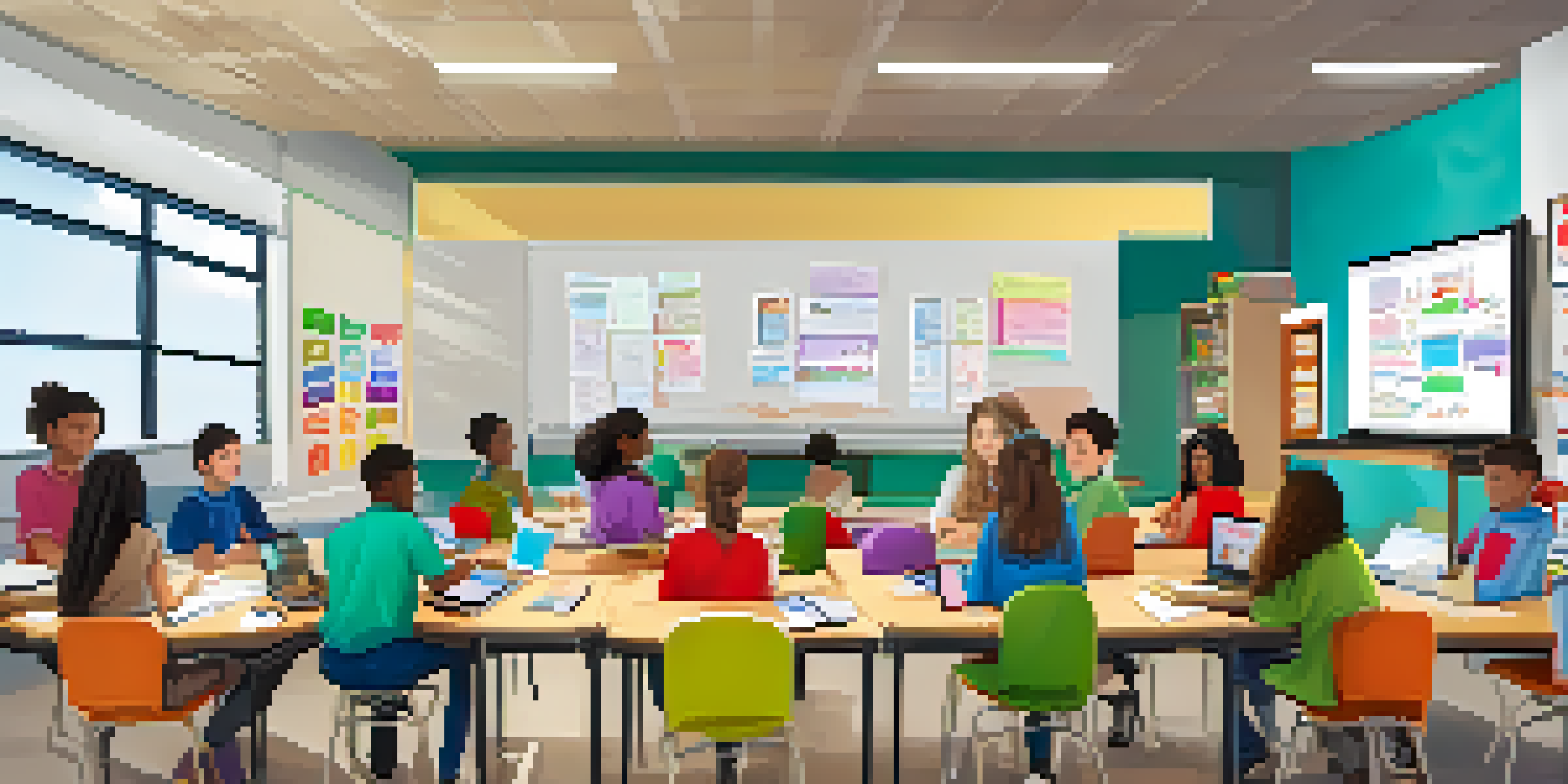Creating Collaborative Learning Environments in Blended Models

Understanding Blended Learning and Its Importance
Blended learning combines traditional face-to-face teaching with online methods, creating a dynamic educational experience. This model not only provides flexibility but also caters to diverse learning styles, making it essential in today's educational landscape. By leveraging both in-person interactions and digital tools, educators can create rich, collaborative environments that enhance student engagement and retention.
The art of communication is the language of leadership.
In a blended learning environment, students can learn at their own pace while still benefiting from direct interaction with instructors and peers. This combination fosters a sense of community and encourages active participation. As technology continues to evolve, the importance of blended learning will only grow, making it crucial for educators to adapt their strategies accordingly.
Understanding the principles of blended learning is the first step towards creating collaborative learning environments. It sets the stage for developing strategies that not only enhance individual learning but also promote teamwork and communication among students.
The Role of Technology in Collaboration
Technology is a powerful enabler of collaboration in blended learning environments. Tools like video conferencing, discussion forums, and collaborative platforms allow students to connect and work together, regardless of their physical location. This connectivity not only breaks down geographical barriers but also encourages diverse perspectives, enriching the learning experience.

For instance, using tools like Google Docs allows multiple students to contribute to a project simultaneously, facilitating real-time collaboration. This not only enhances communication skills but also teaches students to value each other's contributions. By integrating technology effectively, educators can create a seamless blend of individual and collaborative work.
Blended Learning Enhances Engagement
By combining in-person and online methods, blended learning fosters flexibility and caters to diverse learning styles.
Moreover, technology can help streamline communication, making it easier for students to share ideas and feedback. This creates a more supportive learning environment where collaboration thrives, ultimately leading to better educational outcomes.
Designing Collaborative Learning Activities
Effective collaboration starts with carefully designed learning activities. Educators should aim to create tasks that require input from multiple students, encouraging them to share ideas and work together towards a common goal. For example, group projects or peer review sessions can foster a sense of teamwork and collective responsibility.
Alone we can do so little; together we can do so much.
It's also essential to consider the diversity of student backgrounds and learning preferences when designing these activities. Incorporating varied roles within group tasks can ensure that each student feels valued and contributes meaningfully. This not only enhances collaboration but also builds essential skills such as empathy and adaptability.
Ultimately, well-structured collaborative activities can lead to deeper learning experiences. They encourage students to think critically, solve problems together, and build relationships, all of which are vital for success in both academic and professional settings.
Establishing Clear Communication Norms
Clear communication is the backbone of successful collaboration in any learning environment. Establishing communication norms at the outset helps set expectations and fosters a respectful, open dialogue among students. For example, outlining how often teams should meet and preferred methods of communication can streamline interactions.
Encouraging students to express their thoughts and ideas openly can lead to richer discussions and more effective collaboration. It’s important to create a safe space where all voices are heard, promoting inclusivity and respect among peers. Regular check-ins can also help ensure that everyone is on the same page and feels comfortable sharing.
Technology Fuels Collaborative Work
Tools like video conferencing and collaborative platforms break geographical barriers, enriching the learning experience through diverse perspectives.
By prioritizing clear communication, educators can facilitate smoother collaboration, helping students navigate challenges together. This not only enhances the learning experience but also prepares them for collaborative work in their future careers.
Fostering a Sense of Community
A strong sense of community is vital for collaborative learning. When students feel connected to their peers, they are more likely to engage actively and support each other’s learning. This can be achieved through icebreakers, group discussions, and shared goals that promote camaraderie and mutual respect.
Creating opportunities for informal interactions, such as virtual coffee breaks or group chats, can also help strengthen bonds among students. These moments encourage relationship-building, which is essential for effective collaboration. A community-oriented approach fosters trust, allowing students to feel comfortable sharing ideas and taking risks.
Ultimately, a sense of community transforms the learning environment, making it more enjoyable and enriching. Students who feel connected are not only more engaged but also more likely to collaborate effectively, leading to stronger learning outcomes.
Assessing Collaborative Learning Outcomes
Assessment plays a crucial role in understanding the effectiveness of collaborative learning. Educators should implement both formative and summative assessments to gauge how well students are working together and achieving learning objectives. This can include peer assessments, group reflections, and individual contributions to team projects.
Using rubrics that outline specific criteria for collaboration can provide clear expectations and help students understand what is being assessed. It can also encourage them to take ownership of their roles within the group. By focusing on both individual and group performance, educators can gain insights into how collaboration impacts learning success.
Community Builds Collaborative Success
Fostering a sense of community among students encourages active participation, trust, and effective collaboration for better learning outcomes.
Regular feedback is also essential in the assessment process. It allows students to reflect on their collaborative efforts and make necessary adjustments, ensuring continuous improvement and growth.
Overcoming Challenges in Collaborative Learning
While collaborative learning offers numerous benefits, it also comes with its challenges. Issues such as unequal participation, conflicts, and communication barriers can hinder effective collaboration. It’s vital for educators to be aware of these potential obstacles and proactively address them.
Implementing strategies like assigning roles, setting clear expectations, and providing conflict resolution resources can help mitigate these challenges. Encouraging open dialogue among group members about their concerns can also foster a more supportive environment. Educators should be prepared to intervene when necessary, guiding students towards constructive solutions.

By acknowledging and addressing challenges head-on, educators can create a more resilient collaborative learning environment. This not only enhances the learning experience but also equips students with the skills to navigate teamwork challenges in their future endeavors.